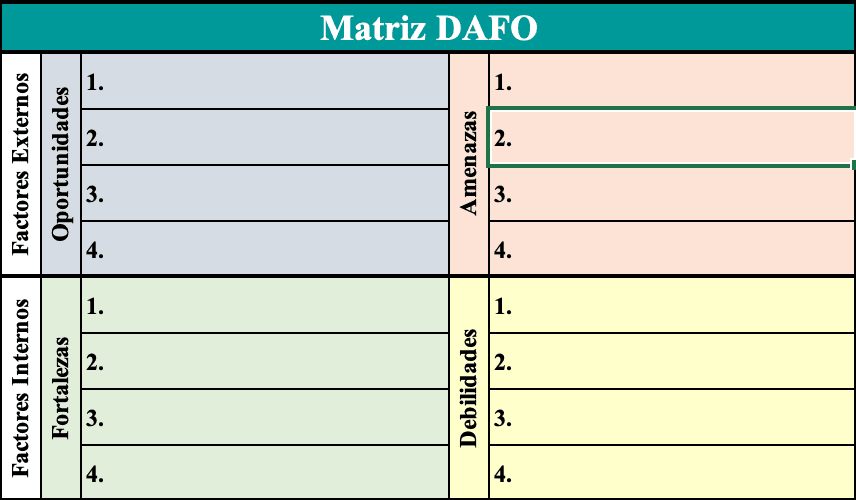The SWOT matrix is a simple but powerful and effective tool to help you develop your business and personal strategies. A SWOT analysis helps you determine the direction of your business and set strategies regardless of the stage you are in.
So what is a SWOT analysis and how is the strategic analysis done?
In this article, we will explain step by step, everything you need to know about the SWOT matrix.
What is the SWOT matrix
The SWOT matrix is a strategic planning tool that aims to identify the strengths, weaknesses, opportunities and threats involved in the development of a company or project in order to develop strategies, tactics, goals and objectives in the short and medium term. Its main value is that it allows a self-assessment of business management.
The word formed with the acronym SWOT or also known as SWOT means: Weaknesses, Threats, Strengths and Opportunities.
The SWOT matrix is designed in a grid where the 4 characteristics are organized:
- External factors: opportunities and threats. These are those situations over which there is a certain degree of control.
- Internal factors: strengths and weaknesses. Refers to situations that occur outside the company.


Download our customized template in excel format here? SWOT analysis template ?
Strengths (internal factor)
Strengths are the organization’s own characteristics that help it achieve its objectives. They are the positive, tangible and intangible attributes that make it stand out from the crowd. To perform the strategic SWOT analysis, analyze the strengths of each aspect related to the objective:
- Capabilities (Do we have the capacity to do…?).
- Economic stability and financial resources.
- Human resources (development programs, motivation, sense of belonging).
- Marketing and sales processes (expert salespeople with full knowledge of the product).
- Brand recognition and reputation (long track record).
- Effectiveness and efficiency of processes (manufacturing, distribution, communication).
- Customer loyalty.
Weaknesses (internal factor)
Weaknesses are those attributes, characteristics or situations present in the company that prevent the achievement of the company’s objectives. In short, by identifying the failures and deficiencies of the company, they can be addressed and reduced. What are we not good at? What are we lacking? Analyze aspects such as:
- Financial weaknesses (resource management, economic stability, poorly developed budgets).
- What is the opinion of our customers? (What do they say?).
- Internal weaknesses (poorly managed processes, slowness).
- Brand image (weak visual image, no clear policy defined).
- Human resources (learning and growth plans).
Opportunities (external factor)
The opportunities in a SWOT matrix refer to situations that are external to the company but are favorable because they help or could help achieve the project’s objective. What opportunities does the business environment offer us? Some aspects to analyze are:
- Financial opportunities (Can we buy from a weaker competitor due to the current pandemic situation?).
- Emerging technologies that can help us be more competitive.
- What opportunities do we have with customers? (What can we bring to them?).
- Opportunities within the organization (What processes can we improve to adapt to climate change? Would telecommuting benefit us?).
- Professional development (Can we take advantage of the capacity of some of our staff members to provide refresher courses for the rest of the staff?)
Threats (external factor)
Threats to consider in a SWOT matrix are those situations that occur outside the company and risk the success of its objectives. Although sometimes they cannot be controlled, knowing the threats and risks will help to face the challenges. Are there new legal requirements that will affect the business?
- Financial sector (What threats could affect our financial stability?).
- Customer behavior (What are our concerns about our customers? Why is the number of new customers trending negatively?).
- Environmental factors (What environmental factors could harm us?).
When to use a SWOT analysis?
A SWOT analysis can be used when required:
- Define strategies in a company that is starting its business activities.
- Analyze the current situation of the organization and define strategies for moving forward.
- Develop the company’s business plan.
- Analyze and define strategies in the development of a given project.
- Solve problems.
- Analyze the competition and define strategies to act against it.
- It is also useful to make your personal development plan.
How to perform a SWOT analysis?
The following is the recommended methodological process for the development of a successful SWOT analysis.
Step 1. Preparing for the SWOT analysis
- Be prepared, a SWOT analysis can take up a whole day’s work.
- Select the people who will participate in the development of the SWOT analysis. Analytical people who are experts in the subject and who are knowledgeable about business policies and the surrounding environment should attend. The idea is to bring together people with different ways of looking at the business and different perspectives. Each person will gather any useful information (reviews, statistics, customer feedback, etc.).
- Define the objective and scope of the SWOT analysis.
- If necessary, explain to the team what a SWOT matrix is and its importance.
- Also, define what the rules of the dynamic will be.
- Create a template for the SWOT matrix, either in an Excel sheet or by downloading a template from an online platform.
Step 2. Brainstorming and forming the SWOT Matrix
- At the beginning, allow free generation of ideas in silence, for about 10 minutes. Each participant will write their ideas on a piece of paper (strengths, weaknesses, opportunities and threats). This will help the group focus on the objective.
- At the end of the time, start with the SWOT analysis. According to the rules of the group dynamics you established, allow each person to say his or her idea and record it on the template. Encourage participation.
- The time has come to analyze and “clean up” all the ideas. You must select the ideas that are really relevant and eliminate those that are repeated and those that are not of strategic importance. An effective SWOT analysis is based on facts and data. Therefore, the information must be real and well analyzed.
Step 3. Develop the four SWOT strategies.
At this stage, examine the SWOT matrix for connections and develop strategies for each aspect.


Download our customized template in excel format here?SWOT analysis template?
Strengths-opportunity
FO strategies leverage internal strengths to maximize opportunities in the external environment. In other words, they are the strategies that define the visions and goals of the project. Do any strengths support the identified opportunities?
Strengths and Threats Strategies
The idea is to develop strategies that leverage internal strengths to minimize threats from the outside. If your business is strong, it will develop FA strategies that successfully address the threats it faces.
Weaknesses and Opportunities Strategies
These strategies will be useful to minimize your company’s weaknesses by taking advantage of the opportunities that occur in your external environment.
Weaknesses and Threats Strategies
Define defense strategies to overcome business weaknesses in order to minimize external threats. Also known as “survival strategies”.
Tips for developing SWOT strategies
Some tips for performing a SWOT analysis:
- First of all, define the objective of the SWOT strategy analysis very well.
- Develop the SWOT matrix with the participation of several people with diverse perspectives.
- Make sure everyone understands what a SWOT matrix is and how it works.
- Encourage people to speak frankly, without fear.
- Encourage participation from all team members.
- When eliminating ideas, use a voting system.
- Analyze the competition when developing external factors.
- Be as specific as possible when describing each of the factors as this will make strategy development more effective.
- Define responsibilities and dates for each strategy.
Advantages and disadvantages of a SWOT analysis
Here are some of the advantages and disadvantages of a strategic SWOT analysis.
Advantages of a strategic analysis with the SWOT matrix
- First of all, it is a simple process.
- It allows the identification of risks, threats and opportunities for improvement.
- SWOT is an excellent generator of ideas, encourages participation and improves the sense of belonging.
- It encourages team members to develop strategic thinking.
- The SWOT matrix helps to understand the external environment by analyzing political and environmental threats and preparing for possible events.
Disadvantages of a strategic analysis with the SWOT matrix
- If it is not well directed, the organization can become dispersed and lose focus of what is really necessary to achieve its objectives.
- It is very simple, for large companies, it is necessary to accompany it with a business plan,
- There is no hierarchy with clear priorities, so it is difficult to detect priorities.
- It is common to do analyses that do not last more than a couple of hours resulting in a weak SWOT analysis.
- If it is not done based on sufficient data, wrong strategies can be developed.
Conclusion
A strategic analysis with the SWOT matrix is ideal for small businesses as it can help them understand where to direct their efforts.
The SWOT matrix is an easy-to-use and powerful strategic tool for understanding the strengths, weaknesses, opportunities and threats of your business.
However, it is not a static tool that will remain unchanged over time. The matrix should be evaluated and updated periodically in order to keep you up to date with what is happening both inside and outside the organization.


